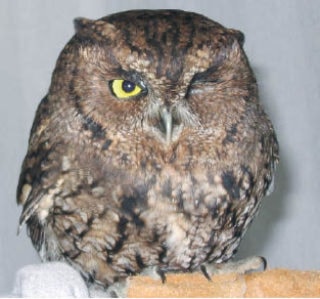During the last few weeks, Mountainaire Avian Rescue Society (MARS) has seen an unusually high number of wildlife cases resulting in a “full house.”
The majority of these cases have been large and small raptors, eagles, hawks and five different species of owls, as well as a number of shore and water birds.
It seems we are not the only part of the world that is experiencing wildlife in trauma, one can only assume that the severe and unusual weather events around the world have resulted in hundreds of birds falling from the sky in the United States, thousands of devil crabs washed ashore as a result of hypothermia in Britain and thousands of box jellyfish in Hawaii, to name but a few.
Certainly the wind, rain and snow storms have all taken their toll on our local wildlife species, especially owls like the western screech owl.
Three of our owl cases sustained head injuries and in two cases, this resulted in severe eye injuries.
The western screech owl is found from southern Alaska down to the Baja Peninsula in Mexico, and is a small nocturnal owl. These owls prefer open woodlands and forest clearings but can also be seen in urban parks and orchards.
This owl is approximately 22 centimetres tall with a 52 centimetre wing span, and weighs approximately 150 grams. There are two species of screech owl – the western and the eastern. They vary in coloration from one habitat to another. Their plumage will differ according to the type of habitat they live in. Those owls that live in more arid areas will have lighter coloration whereas those that are more forest dwellers tend to have darker plumage.
Local populations of western screech owls can also vary in coloration but usually have grey or brown feathers streaked with white and black.
In keeping with owls in general, they have large forward facing eyes that are fixed in their sockets. This is why owls have to turn their heads, they are unable to move their eyes.
Western screech owls have bright yellow eyes with a black beak. Their legs and feet are covered in feathers and they have short ear tufts which can be raised or lowered. The ear tufts and the ability to elongate their bodies, allows them to resemble the horizontal pattern of tree bark, providing them with the perfect camouflage.
One would assume that these owls “screech” as their name suggests and they do occasionally screech if threatened. They also wail, yelp and bark but their usual vocalization is a series of accelerating “toots.”
Screech owls are strictly nocturnal and are most active 45 minutes after dusk. This makes them susceptible to injuries as their hunting time coincides with the human rush hour.
These owls have the nickname of “flying wild cats.” They are ferocious hunters and have been known to capture prey as large as a chicken-sized blue grouse.
These masters of disguise will sit and wait – a technique that allows them to perch patiently awaiting their prey. Once located, they drop down upon the unsuspecting prey, rarely having to put up a chase.
These owls are known as opportunistic feeders and have a wide variety of prey including rodents, insects, small reptiles and amphibians. They have also been known to wade into shallow water to snag a small fish.
Western screech owls are cavity nesters and prefer cavities excavated by pileated woodpeckers and northern flickers. They use only wood chips to cushion their eggs. Normally they produce 4-5 eggs which are incubated by the female who will shed or pluck feathers from her lower belly creating a warm brood patch of bare skin. Feathers are poor conductors of heat.
The male will bring food to the female during incubation and he will also hunt for food once the young are hatched. Both parents fiercely defend their young.
Screech owls have many predators including most of the larger owl species, goshawks, coopers hawks, raccoons and squirrels, snakes and crows (in the nest).
Western Screech owls are part of an ongoing study by the B.C. Ministry of Environment which hopes to reverse habitat damage for species that are endangered, threatened or at risk. For more information visit their web site at www.env.gov.bc.ca/wld.
The screech owl that was treated at MARS was almost certainly hit by a vehicle. Often rodents run along the road edges dining on morsels of discarded human food thrown from passing motorists. Unfortunately, many owls are hit as they attempt to capture the rodent.
Owls have only a thin membrane of skin separating their ear from their eye and any head trauma often results in severe bruising or destruction of the eye.
In our owl’s case, the eye is responding well to medication and it is hoped that the owl will be released. Providing the owl’s hearing is not compromised, nocturnal owls can manage with some visual impairment. We have released one eyed owls.
Please be aware of wildlife on our roads especially in this cold weather. Many species will venture closer to homes in search of shelter or food.
n A date to mark on your calendar is our Eagle Fest which takes place on Feb. 26 in Campbell River. Please watch the local papers for more information or visit our web site at www.wingtips.org.
To report injured wildlife please call our pager at 1-800-304-9968.
